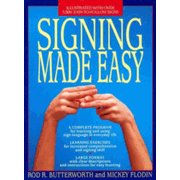Those uninitiated to the signing community, like myself, are often surprised to learn that there is more than one approach to sign language, although some of them share and recognize many of the same signs. Those within the signing community often have strong preferences and strong feelings about which approach to use. Signing Made Easy teaches how to sign following English sentence structure format. The popular American Sign Language (ASL) approach has its own distinctive syntax that doesn’t match standard English. The authors of Signing Made Easy point out that sticking with standard English sentence structures makes it easier for those who already know English to learn signing. It also can provide more literal translations. I don’t have enough familiarity with sign language to judge between the approaches, but I can still make some observations regarding Signing Made Easy.
Signing Made Easy seems to be a much more comprehensive course than other resources I have seen. It teaches more than 3,500 signs, but it also teaches individual letters so that you can spell out proper names or other words for which you don’t know the sign. In addition, students will learn about the uses of articles (a, an, and the), possessives, plurals, punctuation, common suffixes (e.g., er, est, ing, ly), and numbers (up through one million, fractions, and dollar amounts)—all of this is in the introductory material before the first chapter. Students should master the individual letters before starting into the lessons themselves, but they can go back and learn suffixes, numbers, and other skills when they need them.
Lessons are presented within 12 chapters, each on a particular topic (or two) such as “Family and Social Life,” “Work and Careers,” “Food,” and “Travel and Holidays.” First in each chapter is a section titled “Practice Learning Signs.” Signs are shown with images, and they are taught within the context of sentences. So sentences are spelled out in both sign and written words. Some sentences include synonyms right next to one another. For example, in the sentence, “It upset and frustrated /angered/ everyone," signs are shown for both frustrated and angered. In another sentence, the words talking and gossip are taught together with illustrations for the different signs. At the bottom of these pages are more detailed explanations for forming many of the signs. In Chapter 11 on religion, signs for different Christian denominations and signs for priest, pastor, and rabbi are taught along with other religious vocabulary. There are two pages of “Additional Descriptions” at the back of the book as well as an index showing where to find signs for each word taught in the course.
Students should work through these sentences and signs until they think that they have mastered them. The next section within the chapter, “Practice Giving Signs,” provides the same sentences for students to practice signing, but they are presented only in written words. Next, “Fingerspelling Practice” lists words for students to practice spelling out letter by letter to develop speed and proficiency.
“Practice Receiving Signs,” the next section, shows only the images for the signs for the same sentences students have already studied. These sections help students to not only “speak” sign language but also to “hear” it as they practice interpreting signs without the assistance of written words.
Some chapters break new vocabulary sentences down into two groups, following the same sequence of activities for each group of sentences. Chapters conclude with exercises and quizzes. Exercises vary from chapter to chapter, but they include one or more of the following: vocabulary review, multiple choice, matching columns, fill-in-the-blanks, and extra practice. The last two types of exercises require students to come up with signs on their own in different contexts than were in the lesson sentences.
The sentences used in the lessons indicate that the intended audience is college level or adults. For example, “Ed doesn’t drink beer /liquor/” signals a drinking-age audience. “I never imagined the woman’s marriage would end in divorce” and similar sentences deal with adult relationships. And “The electrician decided to announce /cancel/ the strike” seems most understandable for a working adult. Nevertheless, I think the course will still be appropriate for teens in the last few years of high school. It is designed for independent study, although working with other people would certainly be helpful for making sure that you are giving and receiving signs accurately.
Signing Made Easy lays out a method of learning sign language that challenges students to come at it from a number of directions, reinforcing learning far more than does a program that merely teaches students how to form different signs. Of course, much is dependent upon student practice. The thousands of signs can be daunting to learn, and repeated practice is the only way to master them. Students who complete Signing Made Easy can continue to expand their vocabulary by using The Perigree Visual Dictionary of Signing by the same authors.









